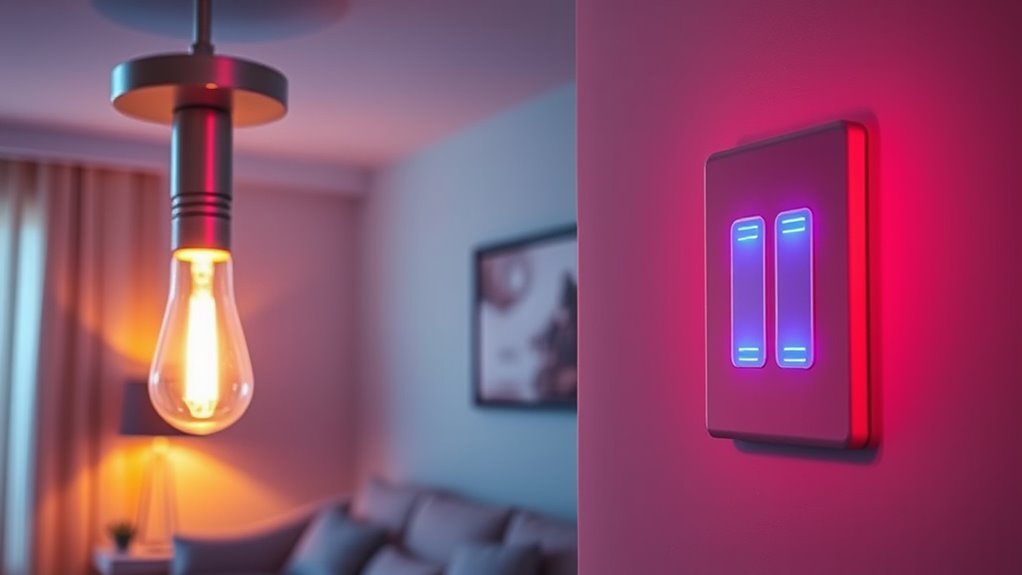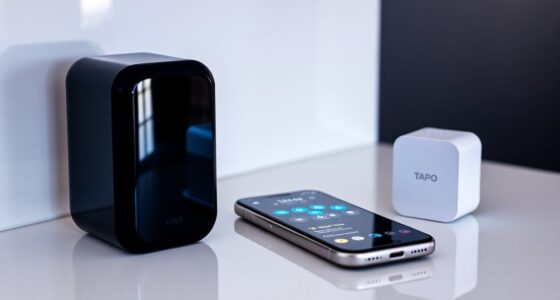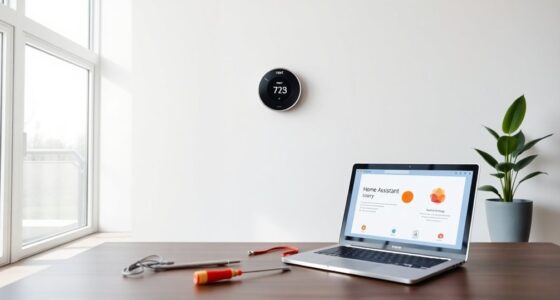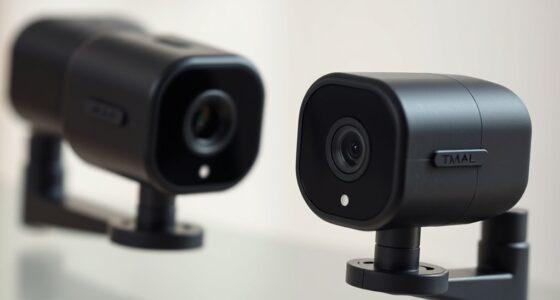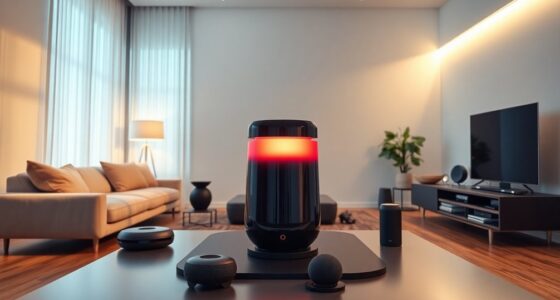When choosing between smart bulbs and smart switches, consider your control preferences, wiring setup, and lighting goals. Smart bulbs offer customizable colors and brightness from your phone or voice, perfect for mood lighting. Smart switches control multiple fixtures with a single tap, ideal for basic control and existing wiring. To decide the best option for your home and discover how each can enhance your space, explore further details below.
Key Takeaways
- Smart bulbs offer customizable lighting and individual control, ideal for mood settings and personalized ambiance.
- Smart switches control entire circuits, providing simple, centralized control over multiple fixtures and improved room automation.
- Installation of smart bulbs is straightforward, while smart switches may require complex wiring, especially in existing setups.
- Smart bulbs tend to be more flexible for user preferences, whereas switches are better for broad, consistent control across multiple fixtures.
- Consider your needs: choose smart bulbs for ambiance and customization, and smart switches for overall room or area control.
Functionality and Control Options
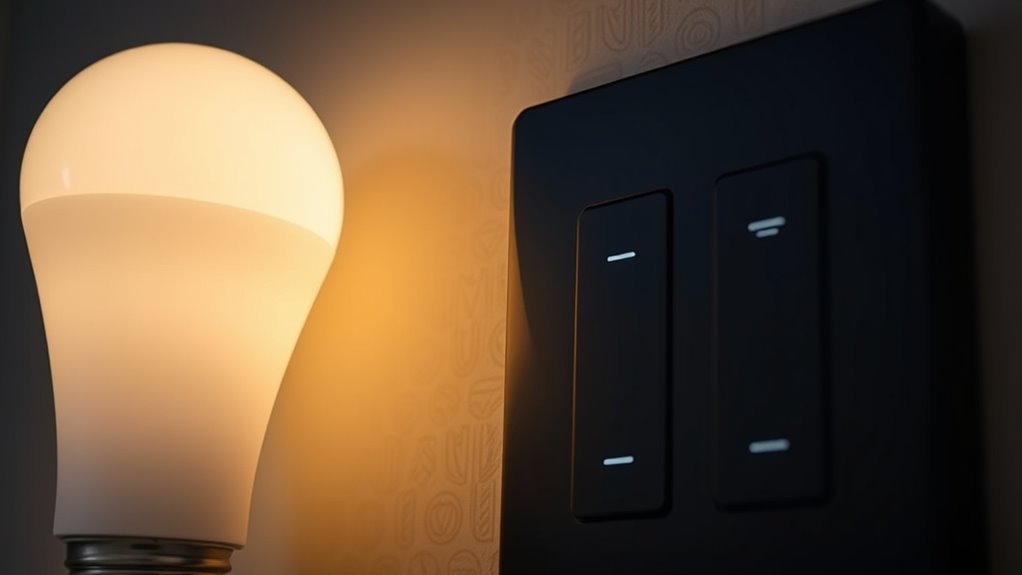
Have you ever wondered how smart bulbs and smart switches differ in their control options? Smart bulbs typically offer remote access through smartphone apps, letting you turn lights on or off from anywhere. They often support voice control via virtual assistants like Alexa, Google Assistant, or Siri, making it easy to manage lighting hands-free. Smart switches, on the other hand, control entire circuits, so they usually don’t provide individual bulb control but can be operated remotely through compatible hubs or apps. Voice control works seamlessly with smart switches too, especially when integrated into a smart home system. Both options enhance convenience, but smart bulbs excel in customizing brightness and color, while smart switches focus on controlling multiple bulbs or fixtures at once. Materials used in smart devices can also influence their durability and compatibility with other smart home products.
Installation and Compatibility Considerations
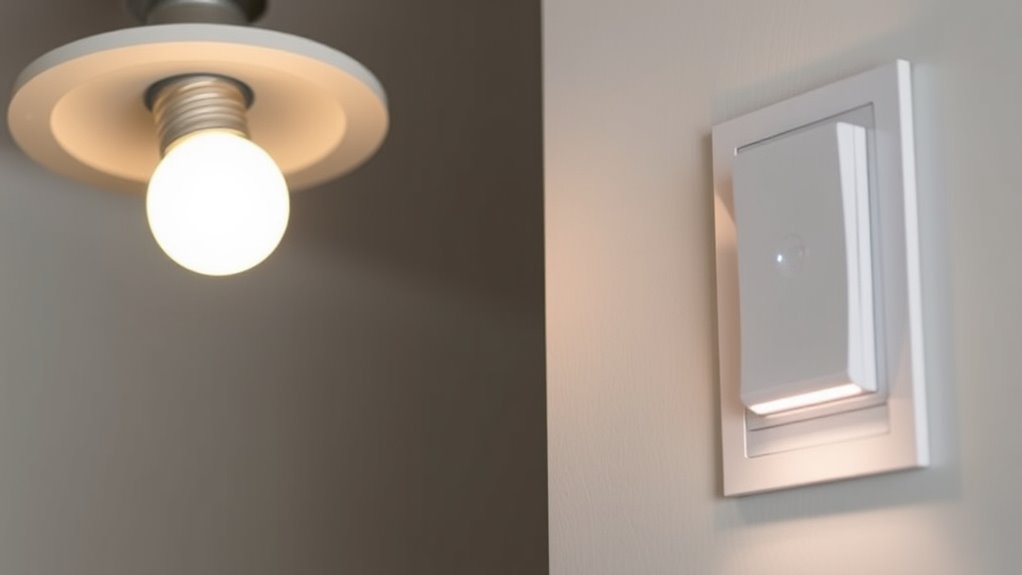
When installing smart bulbs or smart switches, compatibility with your existing wiring and home setup plays a significant role. Smart switches often require more complex wiring, especially if your current setup involves traditional wiring configurations or multiple switches controlling the same light. You’ll need to assess wiring complexity to determine if a switch installation is feasible without rewiring. Smart bulbs, on the other hand, generally have fewer installation hurdles, as they screw into standard sockets. Hardware compatibility is vital—make sure your smart switch supports your electrical system’s voltage and wiring type. Check if your existing switch box can handle the new device, and make certain your smart bulbs are compatible with your fixture types. Proper assessment prevents installation issues and guarantees your smart lighting setup works seamlessly. Additionally, understanding Floating on Water concepts can help you better visualize how water flow and electrical wiring might interact in certain setups, especially in outdoor or poolside environments.
Customization and User Experience
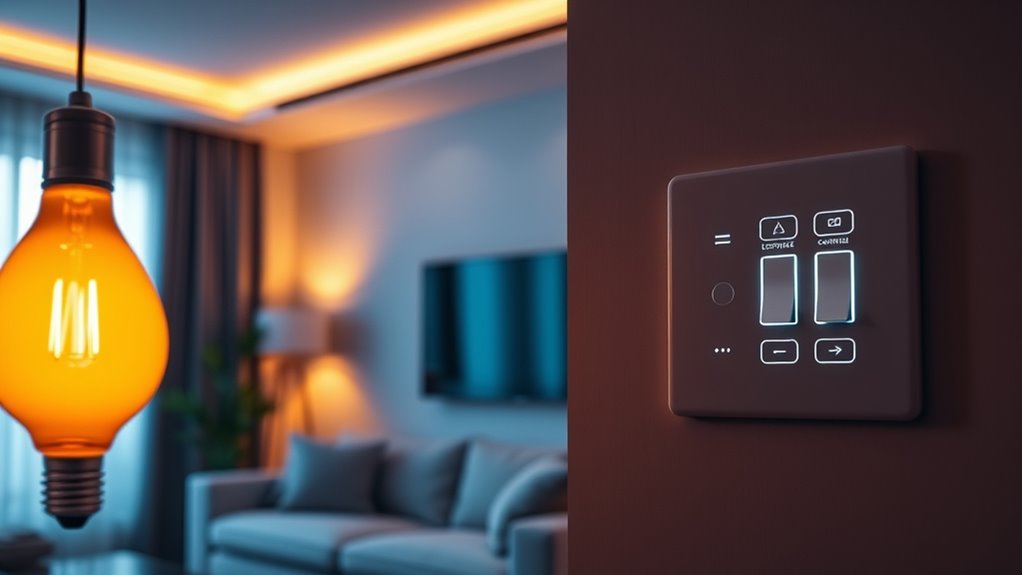
Smart bulbs often provide more extensive customization options, allowing you to adjust brightness, color temperature, and even create dynamic lighting scenes directly through their dedicated apps. With intuitive app interfaces, you can easily fine-tune your lighting to match your mood or activities. Voice commands further enhance your experience, letting you change settings hands-free, whether you’re relaxing or entertaining guests. Unlike traditional switches, smart bulbs offer a personalized touch, giving you control at your fingertips or voice. You can save preferred lighting setups and switch between them effortlessly. This flexibility makes your lighting experience more engaging and tailored to your lifestyle. Overall, smart bulbs prioritize customization, making your space more comfortable and responsive to your preferences.
Energy Efficiency and Cost Implications
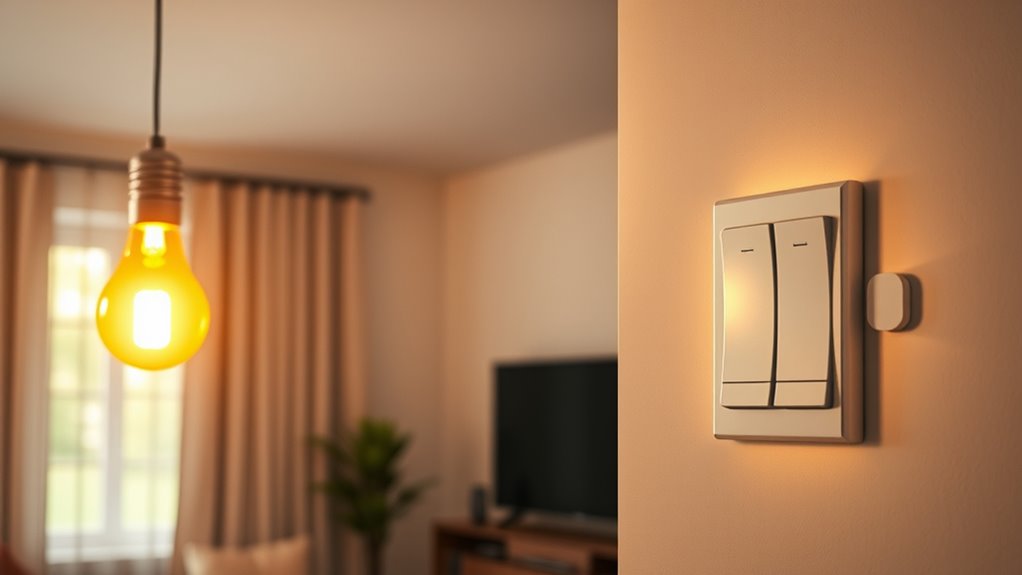
While smart bulbs typically consume less energy than traditional bulbs due to their efficient LED technology, their individual power usage still varies based on brightness and color settings. This impacts your overall energy savings and influences the cost analysis when choosing between smart bulbs and smart switches. Smart bulbs generally lead to lower electricity bills because they use less power and can be dimmed or turned off remotely. However, they tend to be more expensive upfront. On the other hand, smart switches control multiple bulbs and can be more cost-effective for whole-room automation. Consider these points:
- Smart bulbs offer targeted energy savings with customizable brightness.
- Smart switches can reduce overall costs by controlling multiple bulbs with one device.
- Long-term savings depend on usage patterns and initial investment.
- Cost analysis should include bulb lifespan and energy consumption.
Additionally, color temperature options in smart bulbs can influence energy efficiency and user comfort.
Ideal Use Cases and Practical Applications
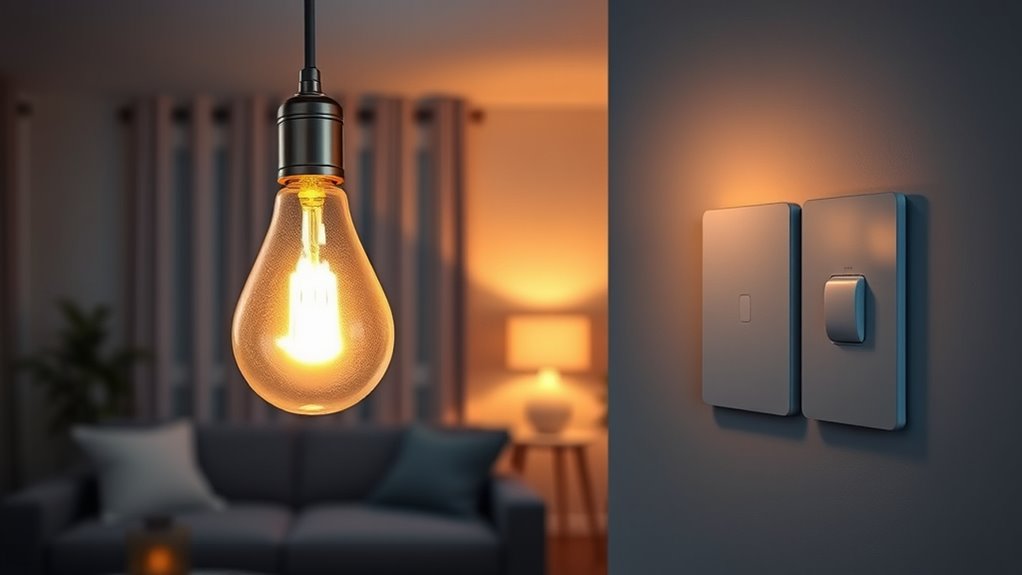
Choosing between smart bulbs and smart switches depends on your specific needs and the room’s usage. If you want customizable lighting effects and voice control, smart bulbs are ideal. They let you adjust brightness, color, and create mood settings effortlessly, making them perfect for living rooms, bedrooms, or entertainment areas. Smart switches, on the other hand, are better suited for controlling multiple lights or fixtures from a single switch, especially in hallways or kitchens. They provide a more traditional look and are great when you prefer voice control to turn on or off entire circuits. Practical applications include using smart bulbs for ambiance and mood lighting, while smart switches are better for overall room control and automation. Consider your habits and room layout to choose what fits best. Additionally, understanding the environmental considerations and the importance of sustainable practices can help ensure your smart home setup remains eco-friendly.
Frequently Asked Questions
Can a Smart Bulb or Switch Be Used With Voice Assistants?
Yes, both smart bulbs and switches are compatible with voice assistants. They support voice command compatibility, allowing you to control your lighting with simple voice commands. Device integration options vary, but most smart bulbs and switches easily connect to popular platforms like Alexa, Google Assistant, or Siri. This means you can effortlessly control your lighting hands-free, enhancing convenience and smart home functionality. Just verify your device supports the specific voice assistant you prefer.
What Happens During a Power Outage With These Devices?
Imagine your smart device flickering, then going dark during a power outage. When power is restored, smart bulbs often turn back on automatically, while smart switches may stay off unless manually reset. To guarantee continuous control, consider backup power options like uninterruptible power supplies (UPS). This way, you stay connected and in control during power restoration, avoiding unexpected surprises and keeping your smart home running smoothly even when the lights go out.
Are Smart Bulbs More Secure Than Smart Switches?
You might wonder if smart bulbs are more secure than smart switches. Generally, smart bulbs face less risk of remote hacking because they connect directly to Wi-Fi and don’t control the entire circuit. However, they’re still vulnerable to remote hacking if not secured properly. Smart switches, being connected to your wiring, face risks from physical tampering and remote hacking if security measures aren’t in place. Stay updated and secure your devices to minimize these risks.
Can I Control Multiple Bulbs or Switches Simultaneously?
Yes, you can control multiple bulbs or switches simultaneously with group control features. Many smart lighting systems let you create scenes or zones, enabling synchronized lighting across various fixtures. You simply set up a group in the app, and then you can turn on, off, or adjust brightness and color for all connected devices at once. This makes managing multiple lights convenient and perfect for consistent ambiance or energy savings.
Do Smart Switches Require Neutral Wires for Installation?
In the age of the digital frontier, smart switches often require a neutral wire for installation. Without it, the installation process becomes tricky, especially in older homes, where neutral wires might be absent. If your wiring lacks a neutral wire, you may need an alternative switch or professional help. Always check your wiring beforehand to guarantee a smooth setup and avoid any surprises down the line.
Conclusion
Choosing between a smart bulb and a smart switch ultimately guides you toward a more seamless home. While each offers unique charms, your lifestyle and preferences gently steer the decision. Embrace the subtle art of automation to create cozy, efficient spaces that feel just right. Whichever you select, you’ll find it’s the quiet touch of modern convenience that turns everyday routines into effortless moments. Step into the future, and let your home softly reflect your smart spirit.
